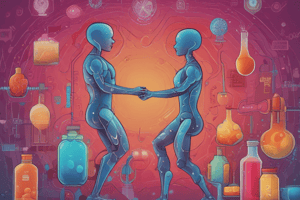Podcast
Questions and Answers
What is the primary method of ATP synthesis during anaerobic conditions?
What is the primary method of ATP synthesis during anaerobic conditions?
- Substrate-level phosphorylation (correct)
- Photophosphorylation
- Chemiosmosis
- Oxidative phosphorylation
Which of the following compounds is NOT an energy-rich compound that can be used to directly resynthesize ATP?
Which of the following compounds is NOT an energy-rich compound that can be used to directly resynthesize ATP?
- 1,3-BPG
- Glucose (correct)
- Creatine phosphate
- PEP
What is the role of NAD+ and FAD in catabolism?
What is the role of NAD+ and FAD in catabolism?
- They act as electron carriers, accepting electrons from substrates and transferring them to the electron transport chain. (correct)
- They act as catalysts to speed up the catabolic reactions.
- They are the final electron acceptors in the electron transport chain.
- They are the primary energy source for the catabolic reactions.
Which of the following is NOT a characteristic of oxidative phosphorylation?
Which of the following is NOT a characteristic of oxidative phosphorylation?
What is the primary function of the electron transport chain in oxidative phosphorylation?
What is the primary function of the electron transport chain in oxidative phosphorylation?
What is the primary role of ATP in cellular metabolism?
What is the primary role of ATP in cellular metabolism?
Which of the following best describes catabolic reactions?
Which of the following best describes catabolic reactions?
What happens during the hydrolysis of ATP?
What happens during the hydrolysis of ATP?
Which statement about metabolic pathways is accurate?
Which statement about metabolic pathways is accurate?
Which process is primarily associated with anabolism?
Which process is primarily associated with anabolism?
The instability of ATP is primarily due to?
The instability of ATP is primarily due to?
In metabolism, what is considered an endergonic reaction?
In metabolism, what is considered an endergonic reaction?
How does ATP contribute to biological transformations of energy?
How does ATP contribute to biological transformations of energy?
Flashcards
ATP
ATP
A molecule that provides energy for muscle contraction and other cellular processes.
ADP + Pi
ADP + Pi
Products formed when ATP is hydrolyzed, which can reform ATP using energy from nutrients.
Substrate-level phosphorylation
Substrate-level phosphorylation
A method of ATP synthesis that occurs through direct transfer of a phosphate group.
Oxidative phosphorylation
Oxidative phosphorylation
Signup and view all the flashcards
Catabolism
Catabolism
Signup and view all the flashcards
Anabolic reactions
Anabolic reactions
Signup and view all the flashcards
Catabolic reactions
Catabolic reactions
Signup and view all the flashcards
ATP (Adenosine Triphosphate)
ATP (Adenosine Triphosphate)
Signup and view all the flashcards
ATP Structure
ATP Structure
Signup and view all the flashcards
ATP cycle
ATP cycle
Signup and view all the flashcards
Exergonic reactions
Exergonic reactions
Signup and view all the flashcards
Endergonic reactions
Endergonic reactions
Signup and view all the flashcards
Study Notes
Overview of Metabolism
- Metabolism is the entire set of enzyme-catalyzed transformations of organic molecules in living cells
- Living cells and organisms carry out work to stay alive, grow and reproduce
- Organisms carry out energy transformations
- Organisms use chemical energy from fuels (food) for synthesis of complex macromolecules from simple precursors
- Organisms use chemical energy for concentration gradients, motion, and heat
Anabolism and Catabolism
- Anabolism: The phase of intermediary metabolism where the synthesis of cell components from smaller precursors occurs (typically a reductive process)
- Catabolism: The phase of intermediary metabolism where nutrient molecules are degraded to yield energy (typically an oxidative process)
Energy Manipulations in Cells
- Metabolic pathways are series of reactions where molecules are degraded or synthesized
- Some pathways release energy; others require energy
- ATP is the energy currency of life, it can be given to pathways that need energy or produced by pathways that release energy
- ATP can be formed by the oxidation of carbon compounds like glucose and fatty acids
- Metabolic pathways are regulated by regulatory enzymes
Structure and Function of ATP
- ATP is the energy currency of cells
- ATP links catabolism and anabolism
- ATP consists of adenosine (adenine + ribose) and three phosphate groups
- Phosphate groups have negative charges which repel each other, making the molecule unstable, and when hydrolyzed release energy.
ATP Cycle
- ATP cycle carries energy from catabolism to energy-requiring processes in cells
- When we eat, nutrients (food) are oxidized by catabolic pathways to produce ATP
- ATP is needed for muscle contraction
- ATP is converted to ADP + Pi
- ADP + Pi can be converted back to ATP using energy from the catabolism of nutrients
Energy-Rich Compounds
- ATP is not the only energy rich compound that can be spontaneously hydrolyzed and release energy
- Amount of energy released by ATP is small, so it can be resynthesized when another energy-rich compound is hydrolyzed (that releases more energy). Examples of some phosphorylated compounds, include; Phosphoenolpyruvate, 1,3-bisphosphoglycerate, Creatine phosphate, Glucose 1-phosphate, and glucose 6-phosphate
- PEP, 1,3-BPG and creatine phosphate release more energy than ATP hydrolysis
How ATP is Synthesized
- Substrate-level phosphorylation: A metabolic reaction that results in ATP production, supported by the energy released from another high-energy bond, leading to the phosphorylation of ADP
- This process is quicker and less efficient than oxidative phosphorylation
- It can occur in the absence of mitochondria or anaerobiosis
- Oxidative phosphorylation: A process, catalyzed by ATP synthase in mitochondria, where free phosphate is bonded to ADP using energy from the electron transport chain
- It's the most frequent source of ATP production
- Oxygen is required
Catabolism Overview
- Catabolism is a process where substrates (lipids, carbohydrates, proteins) lose electrons in an oxidative process.
- Oxidized coenzymes (NAD+, FAD+) collect the electrons from substrates
- Electrons are transferred to the electron transport chain to allow for ATP formation
Oxidation-Reduction (Redox) Reactions and Coenzymes
- A redox reaction is one where electrons are transferred from a donor to an acceptor molecule
- Oxidation: The loss of electrons from a compound
- Reduction: The gain of electrons by a compound
- Examples of redox coenzymes include NAD+/NADH, NADP+/NADPH and FAD+/FADH2
Studying That Suits You
Use AI to generate personalized quizzes and flashcards to suit your learning preferences.




